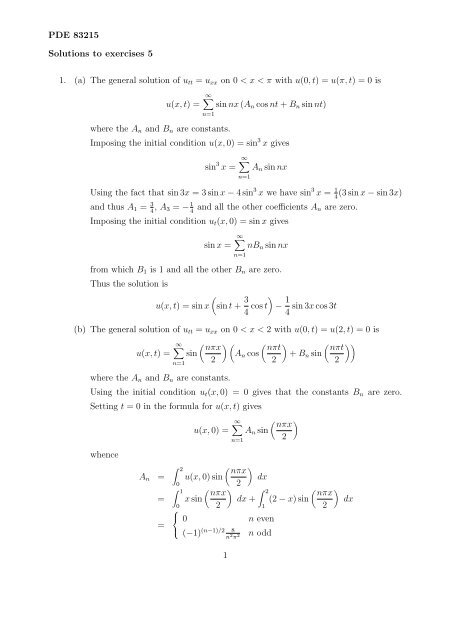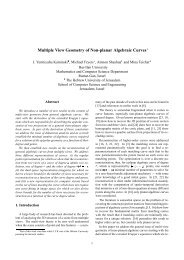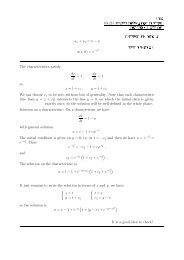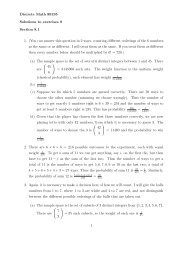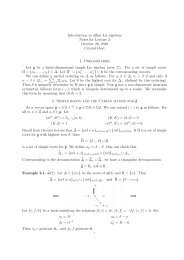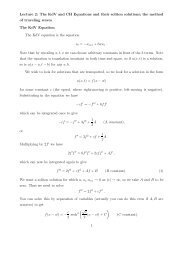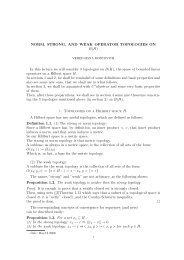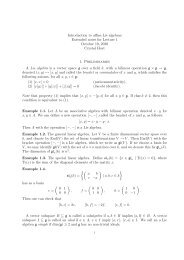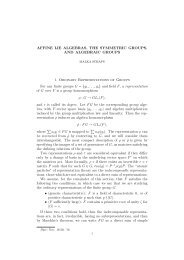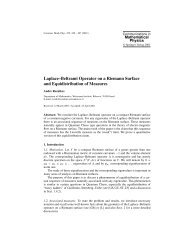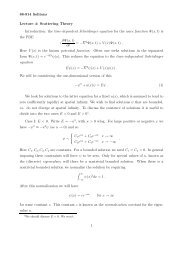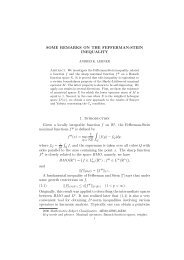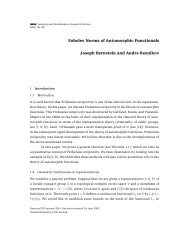PDE 83215 Solutions to exercises 5 1. (a) The general solution of utt ...
PDE 83215 Solutions to exercises 5 1. (a) The general solution of utt ...
PDE 83215 Solutions to exercises 5 1. (a) The general solution of utt ...
Create successful ePaper yourself
Turn your PDF publications into a flip-book with our unique Google optimized e-Paper software.
We just need <strong>to</strong> implement the intial conditions. <strong>The</strong> u condition gives A n = 0,the u t conditions gives that all the B n should be zero except B 3 and B 3 = 118u(x, t) = 1 6( 13 sin 3t − t cos 3t )sin 3xOn reflection it is clear that only the sin 3x mode is excited. and we could havesaved some time by using this. See the next question.(d) This time we will be smarter! We guess a <strong>solution</strong> in the formu(x, t) = T 0 (t) + T 1 (t) cos x + T 2 (t) cos 2xIt satisfies the boundary conditions. To make it satisfy the differential equationwe need <strong>to</strong> imposeT ′′0 (t) + kT ′ 0(t) = 1T ′′1 (t) + kT ′ 1(t) + T 1 (t) = qT ′′2 (t) + kT ′ 2(t) + 4T 2 (t) = 0<strong>The</strong> initial conditions (don’t forget cos 2 x = 1 (1 + cos 2x)) give2T 0 (0) = 1 2, T ′ 0(0) = 0T 1 (0) = 0 , T ′ 1(0) = 0T 2 (0) = 1 2, T ′ 2(0) = 1Solving the 3 differential equations for T 0 , T 1 , T 2 is a straightforward exercise inODEs. I used Maple <strong>to</strong> get the following:T 0 (t) = 1 2 − 1 k + t 2 k + 1 k 2 e−kt⎛ ⎛√T 1 (t) = q − qe −kt/2 ⎝cos ⎝1 − k22 t ⎞⎠ +⎛√k√ sin ⎝ 1 − k24 − k2⎛ ⎛T 2 (t) = e −kt/2 ⎝ 1 √ ⎞⎛2 cos ⎝ 4 − k24 t ⎠ + 2 + k √2sin ⎝16 − k2⎞⎞2 t ⎠⎠√ ⎞⎞4 − k24 t ⎠⎠We could have made our lives even easier here had we noticed that q only excites thecos x mode.6
3. Let us write u(x, t) in the form<strong>The</strong>nand∞∑( ) nπxu(x, t) = f n (t) sinn=1L∞∑( ) nπxu t (x, t) = f n(t) ′ sinn=1L∞∑ ∞∑( ) ( )nπx mπxu t (x, t) 2 = f n(t)f ′ m(t) ′ sin sinn=1 m=1L Lwhen we integrate this expression over [0, L] the only terms that will contribute arethose with m = n. Using the principle that the average <strong>of</strong> sin 2 is 1 2we have∫ L0u t (x, t) 2 dx = L 2∞∑f n(t) ′ 2n=1Similarlyand∞∑( )nπ nπxu x (x, t) =n=1L f n(t) cosL∞∑ ∞∑u x (x, t) 2 nmπ 2( ) ( )nπx mπx=fn=1 m=1L 2 n (t)f m (t) cos cosL L∫ LP<strong>utt</strong>ing everything <strong>to</strong>gether we haveE = ρ 2∫ LNow we use the form <strong>of</strong> f n (t):Differentiating gives00u x (x, t) 2 dx = L 2(u2t + c 2 u 2 x)dx =ρL4∞∑n=1n 2 π 2L 2 f n(t) 2(∞∑f n(t) ′ 2 + c2 n 2 π 2 )fn=1L 2 n (t) 2( ) ( )nπctnπctf n (t) = α n cos + β n sinLLf ′ n(t) = nπcL( ( nπct−α n sinL) ( )) nπct+ β n cosLand thusf n(t) ′ 2 + c2 n 2 π 2fL 2 n (t) 2 = c2 n 2 π 2 ( )α2L 2 n + βn2<strong>The</strong> energy is thus writtenE = ρc2 π 24L∞∑n ( )2 αn 2 + βn2n=17
It is not dependent on time!<strong>The</strong> case <strong>of</strong> Neumann boundary conditions is almost identical. <strong>The</strong> <strong>solution</strong> can bewritten∞∑( ) ( ( ) ( ))nπx nπctnπctu(x, t) = α 0 + β 0 t + cos α n cos + β n sinn=1LLL<strong>The</strong> “zero mode” does not contribute <strong>to</strong> u x , but adds β 0 <strong>to</strong> u t . <strong>The</strong> energy turns o<strong>utt</strong>he same as in the Dirichlet case with the addition <strong>of</strong> a further contribution from thezero mode <strong>of</strong> size.12 ρLβ2 0Note that α 0 does not contribute — it represents a translation <strong>of</strong> the string and doesnot contribute <strong>to</strong> the energy. β 0 (which has the units <strong>of</strong> speed) represents an overallmotion <strong>of</strong> the string, which has mass ρL. So the above contribution is just the usual“ 1 2 mv2 ” expression for kinetic energy.8
4. (a) To make the boundary conditions homogeneous we write<strong>The</strong> function v must satisfyWe look for a <strong>solution</strong> in the formu(x, t) = xt + v(x, t)v tt − v xx = cos 2t cos 3xv x (0, t) = v x (π, t) = 0v(x, 0) = cos 2 xv t (x, 0) = 0v(x, t) = T 0 (t) + T 2 (t) cos 2x + T 3 (t) cos 3x<strong>The</strong> boundary conditions are satisfied. <strong>The</strong> differential equation givesand the initial conditions giveSolving these equations givesT ′′0 = 0T ′′2 + 4T 2 = 0T ′′3 + 9T 3 = cos 2tT 0 (0) = 1 2, T ′ 0(0) = 0T 2 (0) = 1 2, T ′ 2(0) = 0T 3 (0) = 0 , T ′ 3(0) = 0<strong>The</strong> final <strong>solution</strong> isT 0 (t) = 1 2T 2 (t) = 1 cos 2t2T 3 (t) = 1 (cos 2t − cos 3t)5u(x, t) = xt + 1 2 + 1 2 cos 2t cos 2x + 1 (cos 2t − cos 3t) cos 3x5(b) To make the boundary conditions homogeneous we write(u(x, t) = v(x, t) + x sin t + x 1 − x )2π9
<strong>The</strong> function v must satisfyv tt − 4v xx = − 4 π + sin tv x (0, t) = v x (π, t) = 0(v(x, 0) = x2 xπ π − 3 2)v t (x, 0) = 0<strong>The</strong> boundary conditions and the initial condition for v t suggest we should lookfor a <strong>solution</strong> <strong>of</strong> this in the form∞∑v(x, t) = T 0 (t) + v n cos nx cos 2ntn=1To satisfy the differential equation T 0 must satisfyT ′′0 = − 4 π + sin tTo satisfy the initial condition for v t , T 0 must satisfyThus we must haveT ′ 0(0) = 0T 0 = − 2t2π + t + T 0(0) − sin tImposing the intial condition for v givesx 2π( xπ − 3 ∞∑= T 0 (0) + v n cos nx2)n=1Integrating givesT 0 (0) = 1 ∫ π x 2 ( xπ 0 π π − 3 dx = −2)π 4Multiplying by cos nx and integrating gives<strong>The</strong> answer:v n = 2 π∫ π0x 2π⎧( xπ − 3 ⎨cos nx dx =2)⎩(u(x, t) = (x − 1) sin t + x 1 − x )− 2t22π π + t − π 4 +0 n even24π 3 n 4∑n=1,3,5,...n odd24cos nx cos 2ntπ 3 n4 10


